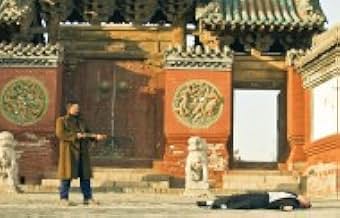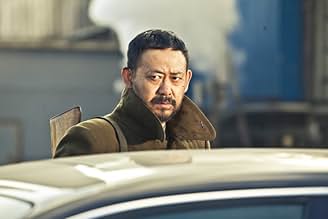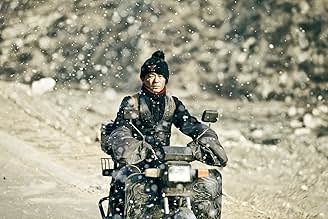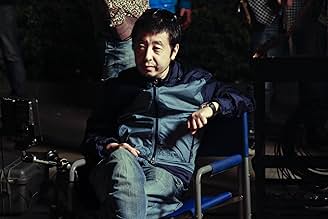NOTE IMDb
7,1/10
14 k
MA NOTE
Quatre histoires indépendantes se déroulent en Chine moderne sur des actes de violence aléatoires.Quatre histoires indépendantes se déroulent en Chine moderne sur des actes de violence aléatoires.Quatre histoires indépendantes se déroulent en Chine moderne sur des actes de violence aléatoires.
- Récompenses
- 18 victoires et 12 nominations au total
Avis à la une
The first minute of this film is better than entire acclaimed English-speaking movies of the year I'm watching it; 2020. But the film is ultimately disappointing.
Every movie director can take nice pictures, but this is a film of not only stunning visuals but stunning visuals time and again imbued with meaning in relation to society and environment.
The film is actually several separate short stories. Short stories can be perfect ideas uncorrupted by the extrapolation necessary for full-length films. But these short films reveal the weakness in lack of depth usually associated with the short film form: the limited time in which, with depth, to tell a tale.
Each of the main characters are victims of their situation, exploited by others in positions of authority in a society built this way. The users are not seen as such by the general mass of the people, who the director shows as dumb animals, most clearly in a scene with a mistreated animal in relation to the scene that it follows.
Though the short films are fleshed-out snapshots, they are snapshots all the same, wasting the promise of meaning imbued in single images. But the great failing is the lack of resolution to each story. A fatuous comeuppance is stuck on almost all as the director takes the easy way out.
These dim-witted "resolutions" are as if these days to end a film this way is more than acceptable, it is acclaimed. It is too easy to simply give up and do a Tarantino. The stories haven't quite lived up to their potential and then are given up on.
Still, despite its flaws, what is good about the film shows a great filmmaker at work.
Every movie director can take nice pictures, but this is a film of not only stunning visuals but stunning visuals time and again imbued with meaning in relation to society and environment.
The film is actually several separate short stories. Short stories can be perfect ideas uncorrupted by the extrapolation necessary for full-length films. But these short films reveal the weakness in lack of depth usually associated with the short film form: the limited time in which, with depth, to tell a tale.
Each of the main characters are victims of their situation, exploited by others in positions of authority in a society built this way. The users are not seen as such by the general mass of the people, who the director shows as dumb animals, most clearly in a scene with a mistreated animal in relation to the scene that it follows.
Though the short films are fleshed-out snapshots, they are snapshots all the same, wasting the promise of meaning imbued in single images. But the great failing is the lack of resolution to each story. A fatuous comeuppance is stuck on almost all as the director takes the easy way out.
These dim-witted "resolutions" are as if these days to end a film this way is more than acceptable, it is acclaimed. It is too easy to simply give up and do a Tarantino. The stories haven't quite lived up to their potential and then are given up on.
Still, despite its flaws, what is good about the film shows a great filmmaker at work.
After some moments of silence, the master of the sixth generation of Chinese filmmakers, Jia Zhangke returns with his newest feature "A Touch of Sin" (2013) which might just be his darkest work to date. It's an intriguing film of sheer brilliance told through the complexity of several, loosely connected stories about people in agony. While some fans of the director may be disappointed by the lack of clairvoyant lyric beauty, characteristic for example for "Still Life" (2006), others may find the narrative ambiguity and incoherence rather enriching.
The film begins with an enigmatic scene at a deserted rural highway where a truck carrying tomatoes has fallen over. A cold sense of brutality breathes in the air. Soon the first characters are introduced and we learn that, in the same way as in "Still Life", "A Touch of Sin" is structured from different stories with different human fates. In brief, it tells the story of four random acts of violence in today's society.
Although the stories lack obvious connection, they all share a few essential elements. First of all, they all escalate to an outburst of violence. Second, all of them are tales of social rootlessness and existential alienation. The latter remark is congruous with the fact that in all of Zhangke's films the general aspect meets the particular in a poignant fashion of chill and solitude. Individuals live in their personal prisons while the modernization of the society brings nothing but empty freedom. In other words, they live in spaces that are both private and public where they feel utterly detached. No one belongs anywhere in the Zhangke universe.
Due to the complexity of several stories, the film also includes more than one central milieu. However, this seemingly arbitrary set of different settings of hotels and a coal miners' town do tell us about veritably similar subjects. All the spaces are haunted by the same problems. Such conflict of ambiguity and coherence should not frighten the spectator. Since instead of a straight-forward narrative with clear character delineation, Zhangke offers us a fascinatingly cynical cross-section of the contemporary Chinese society which is, on the one hand, characterized by economic boom to whose technological wonderland an individual may vanish, and, on the other, the tormenting but also comforting legacy of Mao.
Modern Chinese way of life appears to Zhangke as something diverse -- as something that is in a constant state of change. Like in his previous features, Zhangke once again focuses on the transforming reality, the current flow, and its consequences on the individuals. Although this was already done to an extent in "Still Life" through the complexity of two overlapping stories, it also cast hope in humanity, whereas "A Touch of Sin" is far more pessimistic.
Once again Zhangke's aesthetics of cinema is characterized by the elements of silence and emptiness in the images of loneliness and alienation. It is as though everything had died. Only violence is portrayed passionately, all the rest is understated. The violence in "A Touch of Sin" is raw and brutal, but essentially stripped. Above all, violence appears as a melancholic undertone of some kind which reveals the realities of the society.
Even if the opaque and complex narrative of "A Touch of Sin" left the viewer speechless and unable to describe what he or she had just seen, there is always something profound to admire in Zhangke's cinema. In his films there is always that certain mood which is quite difficult to be put in words. In brief, it is a mood of emptiness, but also of utter richness.
The film begins with an enigmatic scene at a deserted rural highway where a truck carrying tomatoes has fallen over. A cold sense of brutality breathes in the air. Soon the first characters are introduced and we learn that, in the same way as in "Still Life", "A Touch of Sin" is structured from different stories with different human fates. In brief, it tells the story of four random acts of violence in today's society.
Although the stories lack obvious connection, they all share a few essential elements. First of all, they all escalate to an outburst of violence. Second, all of them are tales of social rootlessness and existential alienation. The latter remark is congruous with the fact that in all of Zhangke's films the general aspect meets the particular in a poignant fashion of chill and solitude. Individuals live in their personal prisons while the modernization of the society brings nothing but empty freedom. In other words, they live in spaces that are both private and public where they feel utterly detached. No one belongs anywhere in the Zhangke universe.
Due to the complexity of several stories, the film also includes more than one central milieu. However, this seemingly arbitrary set of different settings of hotels and a coal miners' town do tell us about veritably similar subjects. All the spaces are haunted by the same problems. Such conflict of ambiguity and coherence should not frighten the spectator. Since instead of a straight-forward narrative with clear character delineation, Zhangke offers us a fascinatingly cynical cross-section of the contemporary Chinese society which is, on the one hand, characterized by economic boom to whose technological wonderland an individual may vanish, and, on the other, the tormenting but also comforting legacy of Mao.
Modern Chinese way of life appears to Zhangke as something diverse -- as something that is in a constant state of change. Like in his previous features, Zhangke once again focuses on the transforming reality, the current flow, and its consequences on the individuals. Although this was already done to an extent in "Still Life" through the complexity of two overlapping stories, it also cast hope in humanity, whereas "A Touch of Sin" is far more pessimistic.
Once again Zhangke's aesthetics of cinema is characterized by the elements of silence and emptiness in the images of loneliness and alienation. It is as though everything had died. Only violence is portrayed passionately, all the rest is understated. The violence in "A Touch of Sin" is raw and brutal, but essentially stripped. Above all, violence appears as a melancholic undertone of some kind which reveals the realities of the society.
Even if the opaque and complex narrative of "A Touch of Sin" left the viewer speechless and unable to describe what he or she had just seen, there is always something profound to admire in Zhangke's cinema. In his films there is always that certain mood which is quite difficult to be put in words. In brief, it is a mood of emptiness, but also of utter richness.
Beautiful movie about living at the bottom of the economic class may lead to random violent acts of aggression - as your only way of releasing the anger inside - , it was close but didn't quite make it ..
Story could have been told more visually , with less but useful dialogue , as the cinematography and beauty within the scenes are amazing . But like most art-houses the story doesn't fully add up . -----------------------------------------------------
Part 1: A man living in a village getting drained by the coal mine industry reaches his ultimate limit - and takes out everyone involved in the corporate scandal 8/10
Part 2: A motorcyclist with an excitement to gun violence ; sibling in an aging family, he "robs" people as his way of making a living 5/10
Part 3: A woman is having an affair with a married man but calls it quits for fear it'll ruin her image . Being false accused for being a slut , she makes a drastic decision. 6.5/10
Part 4: A kid gets blamed for injuring a coworker and has to pay his debt through checks for the next 100 days . He calls quits instead and decides to fall in love with a sex worker during his free time . When his life reaches a dead end he decides to end it there . 7.5/10
Overall 7/10 6/10 Script 9/10 Level of Violence 11/10 Violence Shock Value (Realism of Violence) 100/10 Beauty of the Cinematography
Story could have been told more visually , with less but useful dialogue , as the cinematography and beauty within the scenes are amazing . But like most art-houses the story doesn't fully add up . -----------------------------------------------------
Part 1: A man living in a village getting drained by the coal mine industry reaches his ultimate limit - and takes out everyone involved in the corporate scandal 8/10
Part 2: A motorcyclist with an excitement to gun violence ; sibling in an aging family, he "robs" people as his way of making a living 5/10
Part 3: A woman is having an affair with a married man but calls it quits for fear it'll ruin her image . Being false accused for being a slut , she makes a drastic decision. 6.5/10
Part 4: A kid gets blamed for injuring a coworker and has to pay his debt through checks for the next 100 days . He calls quits instead and decides to fall in love with a sex worker during his free time . When his life reaches a dead end he decides to end it there . 7.5/10
Overall 7/10 6/10 Script 9/10 Level of Violence 11/10 Violence Shock Value (Realism of Violence) 100/10 Beauty of the Cinematography
One additional star for the topic that few has tried to film.
In about ten or twenty years, these 120 minutes of social depicting will be one of the very rare and precious visual stories for people to understand and entertain what is going on in the first ten years of the 21st century China. It offers a prospective with some interesting details that makes sense to the westerners or maybe its fellow countrymen in the future. But it doesn't really add up for the people living in China nowadays, or at least, the details are not enough.
Stories are too short that they can barely touch the real psychology that the Chinese laborers are having today. I'm not sure whether it is something that the director fails to do or he is not allowed to do. For example, there are lots of complexities existing between a complaining Shanxi miner and a mad murderer. Throughout the first story, the only real attempt Dahai, who has learned the laws and has close relatives living in the city, has made to disclose the corruption is a mail letter without a specific address. This is far away from the countless efforts that a Chinese miner would make before he explode himself with the illegal riches. To me, the efforts, the struggles, and the final desperate in Dahai's mind are the most interesting parts of the story. However, nothing really happens in the movie. The result is that, Dahai seems more like a legendary cowboy coming from a classic American western movie than a struggling Chinese worker who has relatives to care about.
It touches the social issues we are all witnessing in China today, it is entertaining and somewhat heroic, but it fails to restore the story into reality, let alone into a provoking level.
In about ten or twenty years, these 120 minutes of social depicting will be one of the very rare and precious visual stories for people to understand and entertain what is going on in the first ten years of the 21st century China. It offers a prospective with some interesting details that makes sense to the westerners or maybe its fellow countrymen in the future. But it doesn't really add up for the people living in China nowadays, or at least, the details are not enough.
Stories are too short that they can barely touch the real psychology that the Chinese laborers are having today. I'm not sure whether it is something that the director fails to do or he is not allowed to do. For example, there are lots of complexities existing between a complaining Shanxi miner and a mad murderer. Throughout the first story, the only real attempt Dahai, who has learned the laws and has close relatives living in the city, has made to disclose the corruption is a mail letter without a specific address. This is far away from the countless efforts that a Chinese miner would make before he explode himself with the illegal riches. To me, the efforts, the struggles, and the final desperate in Dahai's mind are the most interesting parts of the story. However, nothing really happens in the movie. The result is that, Dahai seems more like a legendary cowboy coming from a classic American western movie than a struggling Chinese worker who has relatives to care about.
It touches the social issues we are all witnessing in China today, it is entertaining and somewhat heroic, but it fails to restore the story into reality, let alone into a provoking level.
Do not focus on the rate. The film is worth watching even if it could have been much better and some of the details in the scenario are clearly a fail beginning with the lack of coherence of the characters. In clear, it's hard to follow them and to understand them. A Touch of Sin turns out to be a hell of a lot of sins, of violence, of crimes and of desperation. During the film I hesitated between skepticism, bewilders or admiration for this rough and tough portrait of China through different stories that are not necessarily linked together. A touch of sin is about four characters in four different regions in China who are going through hard times, because of globalization, corruption or a closed system. All these things will lead them to crime, suicide and the metaphor of the collapse of the system. It is always better to make a critic out of a movie you have fancied but not all of it is to throw away, and I would recommend to watch that movie for its originality and the ambitious scenario of the director. In short it was a great project and maybe some mistakes could have been avoided, but in the end it's indeed an interesting director to follow in the upcoming years.
Le saviez-vous
- AnecdotesJia Zhang-ke: in the third story as a patron of the brothel. He is shown walking down a hallway from behind talking on his cell phone and smoking a cigar. At the end of the shot he turns to survey the line of girls in the hallway.
- ConnexionsFeatured in At the Movies: Épisode #10.23 (2013)
Meilleurs choix
Connectez-vous pour évaluer et suivre la liste de favoris afin de recevoir des recommandations personnalisées
- How long is A Touch of Sin?Alimenté par Alexa
Détails
- Date de sortie
- Pays d’origine
- Site officiel
- Langues
- Aussi connu sous le nom de
- Touch of Sin
- Lieux de tournage
- Chongqing, Chine(San'er episode)
- Sociétés de production
- Voir plus de crédits d'entreprise sur IMDbPro
Box-office
- Montant brut aux États-Unis et au Canada
- 154 120 $US
- Week-end de sortie aux États-Unis et au Canada
- 19 867 $US
- 6 oct. 2013
- Montant brut mondial
- 854 891 $US
- Durée
- 2h 10min(130 min)
- Couleur
- Mixage
- Rapport de forme
- 2.35 : 1
Contribuer à cette page
Suggérer une modification ou ajouter du contenu manquant



























